Saturday Shoutout / The Right Brain Interweb
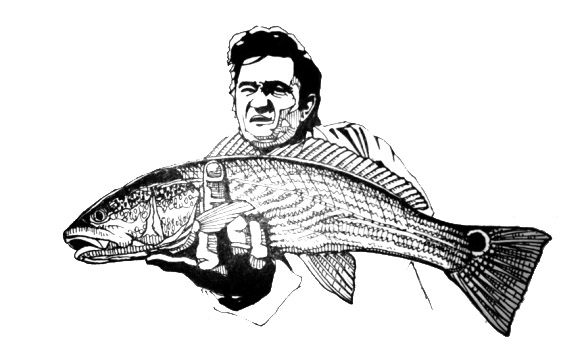
This week we’re sharing some craziest and most creative fun from the fly fishing interweb. Off beat, surly, inappropriate and down right brilliant. Here are three sites I love! Paul Puckett’s “Right Brain Retrieve” features some of his amazing and irreverent art work. “Fishjerks” If you haven’t seen this site, hold on to your hat. This is the craziest fly fishing site on the web. VakMag is a seriously awesome site with a lot of great information. Unfortunately I can’t read a word of it. No worries. You’ll love Pupper og fluefiske!
Read More »Switch Rods for Steelhead
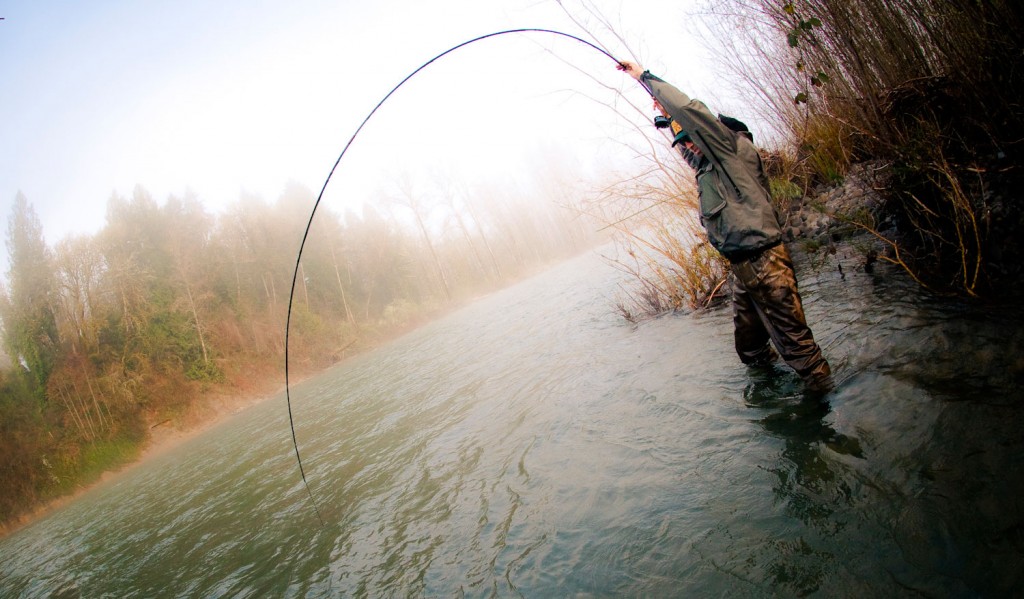
OK, I admit it. I’ve been all about steelhead lately. Can you blame me? Steelhead are addictive and they ruin some guys but so far I’m resisting the urge to move into a shack on a river in the Pacific North West and instead I’m spending that energy on producing endless steelhead content. So here goes. On my recent trip to the Clackamas with my buddy Jeff Hickman I tried something I haven’t done before. I fished switch rods for steelhead. I don’t own a switch rod, (yet) because I thought of it as too light a rod for steelhead. I preferred a twelve foot eight weight spey rod. I have friends who use switch rods for trout fishing and they work well but for wrestling a big west coast chromer, surely not? I was wrong. Jeff likes the switch rod because it’s shorter and it helps him out in tight spots but for me the kick was fighting those tough fish on the lighter rod. It was a blast and those rods will take more pressure than I guessed. A switch rod is a little harder to cast than the longer Spey rod but I fished Jeff’s Ross Reach in a six weight and was kind of surprised. For an inexpensive rod it performed quite well. It casts very nicely and you can really feel it load. If you’re headed out steelheading I’d recommend you think about taking a switch rod. It was a lot of fun and I’m glad I tried it. Jeff talks about switch rods for steelhead. Louis Cahill Gink & Gasoline www.ginkandgasoline.com hookups@ginkandgasoline.com Sign Up For Our Weekly Newsletter!
Read More »Feel the Tarpon Burn
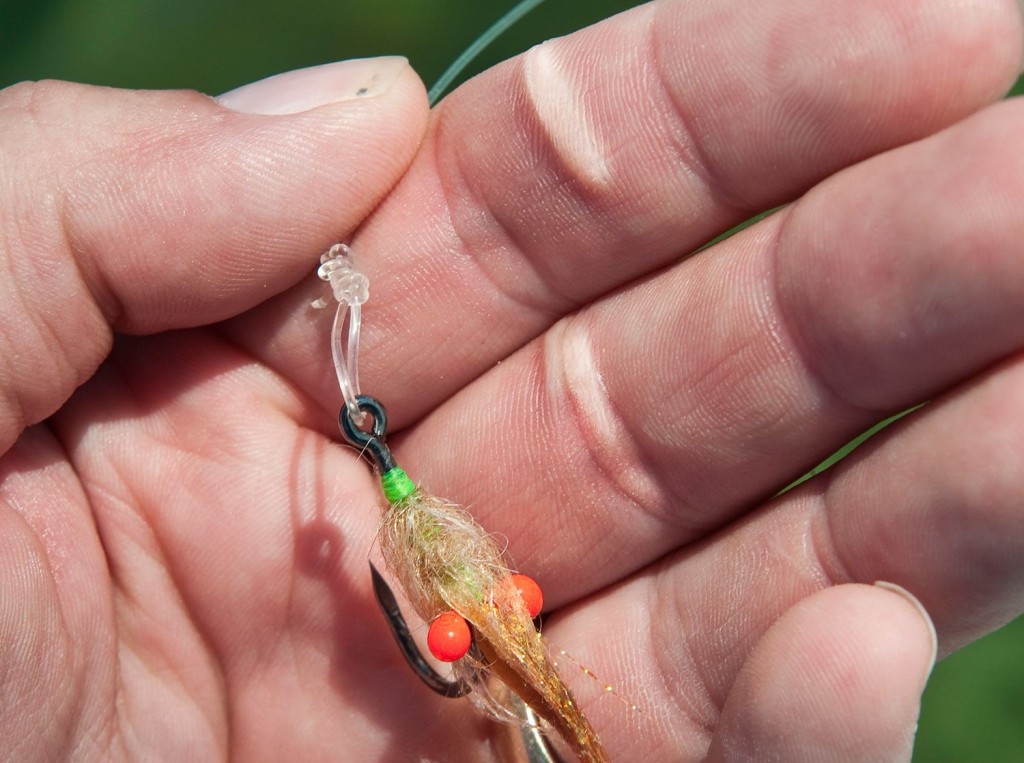
The first step in landing a big tarpon is getting a really good hook set.
If your hook fails to penetrate the hard boney mouth of the tarpon, it almost always will be spit out after the first or second jump. My previous trip to the Florida Keys I experienced just that, walking away with a 0-2 record, all because my hook-sets were piss poor. I wasn’t hitting them hard enough after the eat, and I made a pledge after that trip, that the next time I got a big tarpon to eat, I’d focus 100% solely on making sure my hook set was absolutely perfect. Believe me when I say, it’s humiliating as hell having a guide stare you down after you blow a hook-set. It makes you want to go find a hole to crawl off into.
When Capt. Bruce Chard put me on the biggest tarpon of my life during my latest trip, I set the hook hard and held onto the fly line as long as I could. Come hell or high water, I was going to get that hook completely buried in the tarpons mouth. Low and behold,
Read More »Tying Steelhead Flies That Work, The Sid Fishious
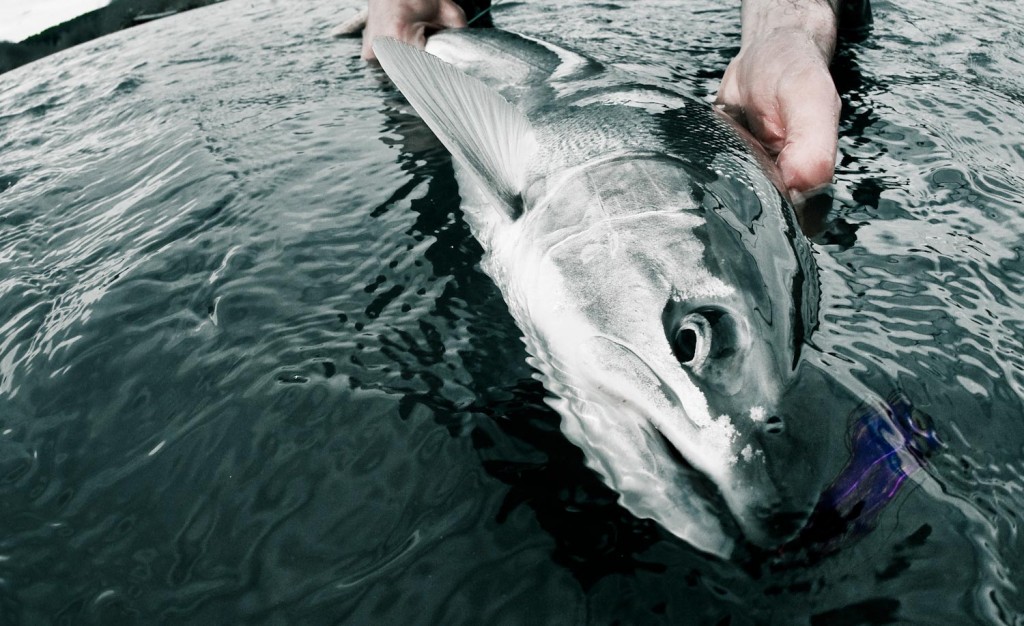
Tying steelhead flies can be a bit mystifying. If you’ve been tying trout flies for a while and are just getting started on steelhead flies there are some important differences. I know that my first steelhead flies were way too heavy and the hook was all wrong. They looked great but they were a pain to fish and my hookup ratio was poor. Getting the right profile, weight and hook placement is easy once you learn a few simple tricks. Healthy dubbing balls help boost your profile and insure great action. Interchangeable trailing hooks make a huge difference. Winter steelhead will frequently just nip at a fly’s tail. Having a sharp trailing hook is important and being able to change that hook if it becomes damaged really extends the life of your fly. Possibly the funnest part of tying steelhead flies are all the great colors you get to play with, and isn’t that what every tyer is really looking for, an excuse to buy more cool tying material? No body ties better steelhead flies than Jeff Hickman. In this video he ties a pattern he originated for Idylwild Flies, The Sid Fishious. It’s a great fly and the techniques that Jeff uses can greatly improve your steelhead flies. Louis Cahill Gink & Gasoline www.ginkandgasoline.com hookups@ginkandgasoline.com Sign Up For Our Weekly Newsletter!
Read More »Sunday’s Classic / Nymph Patterns for Dingy Water
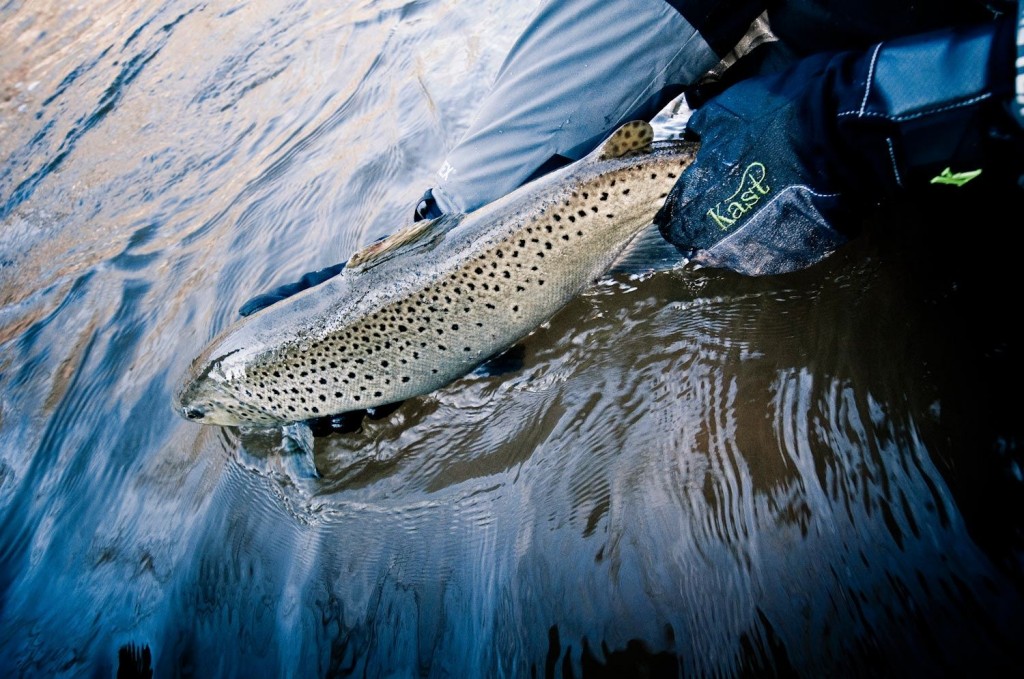
I’ve been on the water many days trout fishing when I’ve had blue bird skies overhead and gin clear water. Then moments later without any warning, an isolated thunderstorm rolls in and dumps a ton of rain, turning that crystal clear water cloudy. When you find yourself trout fishing in dingy or stained water conditions (not referring to blown out conditions) try using nymphs with fluorescent hot beads or patterns with hot spots to increase your number of hookups. They create bright focal points that allow trout to spot them easier when water clarity is subpar. When I’m dealt this hand of cards on the river I’ll tie on a large profile lead fly like a woolly bugger or rubberleg stonefly imitation followed up with one of these flies below as a dropper in my tandem nymph rig. Bright attractor patterns like the San Juan Worm, Y2K and Egg patterns are what I break out next if these patterns below don’t get the job done. They work especially well during extreme dingy water conditions. 1. Dave Hise’s Hetero-Genius Nymph 2. Hot Bead Soft-Hackle 3. Hot Head Pheasant Tail 4. Hot Head Buzzer Midge Attractor 5. Hot Butt Hexagenia Nymph Another situation when these patterns really shine is fishing them during the colder months of the year. When water temperatures drop into the 30s and 40s, trout can often become lethargic due to their low metabolism rate. Fishing flies that have hot focal points can snap the trout out of their trance and create reaction bites. Keep it Reel, Kent Klewein Gink & Gasoline www.ginkandgasoline.com hookups@ginkandgasoline.com
Read More »Saturday’s Shoutout / Kirk Deeter via MidCurrent
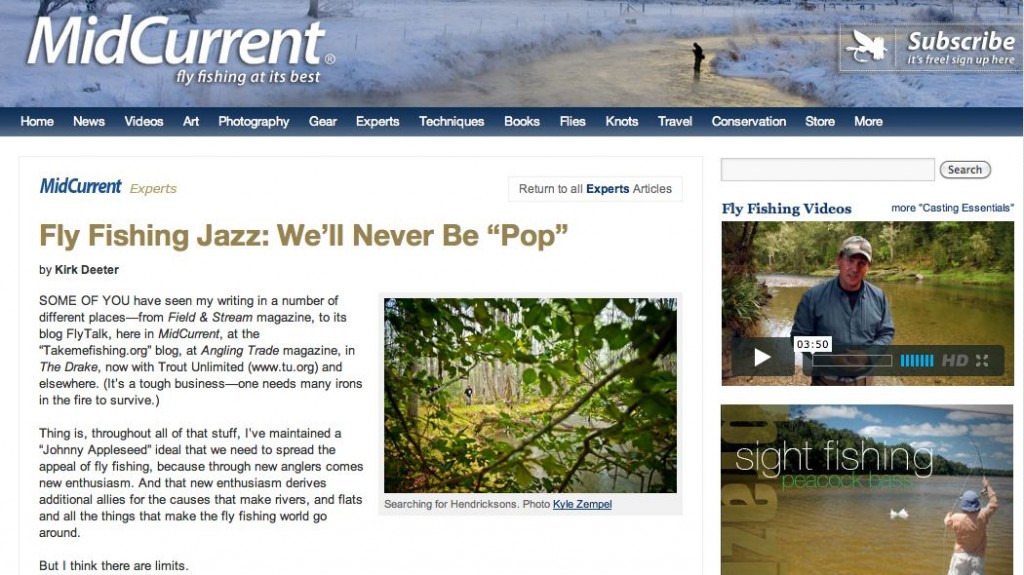
This week’s Saturday shoutout goes to Kirk Deeter via Midcurrent for his moving article titled, Fly Fishing Jazz: We’ll Never Be “Pop”. We can all learn a great deal from Kirk Deeter. His writing style is smooth as butter, and always runs deep with emotions. In my opinion, he’s not just one of the best authors in the business, he’s one of the strongest voices and ambassador’s we have today in the sport of fly fishing. The other day he took time out of his busy schedule to take my phone call and give me life advice. Read the first paragraph of his article and you’ll quickly understand he’s got very little down time. I’ve looked up to him for years, but after I hung up the phone, I realized he was one of the nicest and sincere people I’ve met in a very long time. He treated me like he was my big brother. I think it’s important to share the behind the scenes look at people from time to time. That’s when you see one’s true colors and character. Next time you read one of Kirk’s articles or books, know he’s as genuine and kind hearted as he comes across in his writing. If I get the chance to fish with him down the road, I’m going to be his mobile beer cooler and extreme net man. Thank you Kirk for your unwavering righteous character. Keep it Reel, Kent Klewein Gink & Gasoline www.ginkandgasoline.com hookups@ginkandgasoline.com Sign Up For Our Weekly Newsletter!
Read More »Steelhead Your Face
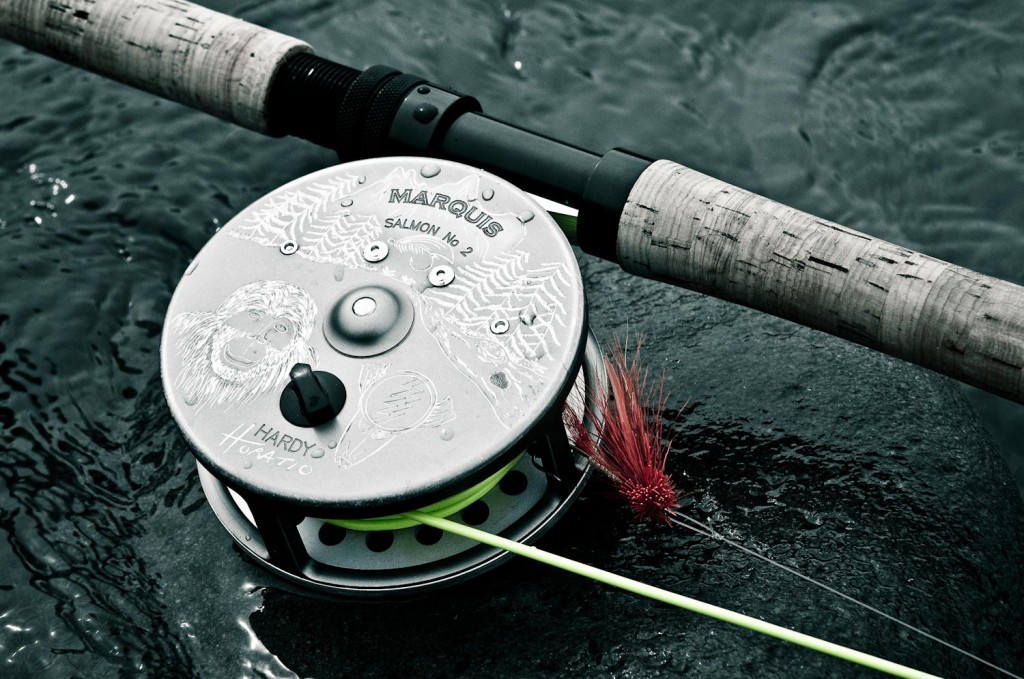
I didn’t see a Sasquach on my trip to Oregon but I did get a glimpse of the reclusive Horatio Nailknot. He walked with a distinctive lopping gate and carried this unique custom engraved Hardy reel. It features some Oregon scenery along with the bust of a Sasquach and a little steelhead for your face. The work was done by Bart Mills of Portland, known to his friends as “The Jeweler”. I like that name, it sounds vaguely sinister and apparently Oregon steelheaders all use an alias. Louis Cahill Gink & Gasoline www.ginkandgasoline.com hookups@ginkandgasoline.com Sign Up For Our Weekly Newsletter!
Read More »The Moth Larva Hatch
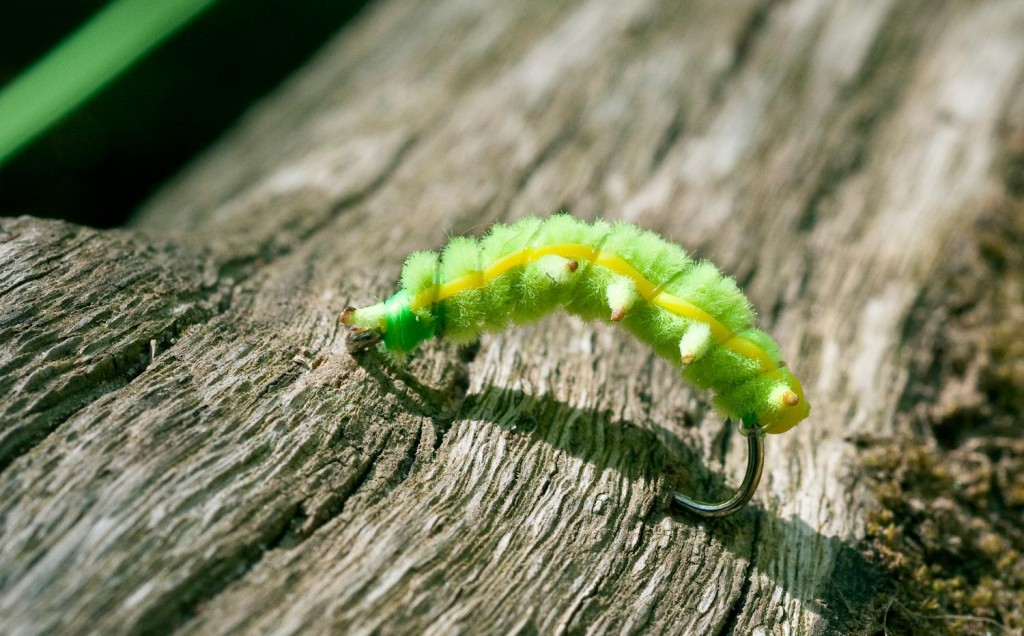
AS I RELIVED LAST YEAR’S SPRING FISHING SEASON IN MY HEAD SEARCHING FOR THE PERFECT HATCH, THE COLOR OF BRIGHT GREEN BEGAN ENTERING MY CONSCIENCE, AND BAM! LIKE A SLAP TO THE FACE, IT HIT ME.
Every year we get a month-long trout feeding frenzy, as moth larva burst onto the scene by the tens of thousands. Yes, I’m talking about the green weenie, the inch worm. The tree limb-repelling caterpillars that every trout in the stream will gorge themselves on through the month of May, and well into summer. Multiple species of moth larva ranging from 1-2″ long annually coordinate a synchronized blanket hatch during late spring that ends up packing the bellies of trout with protein-rich, green gummy goodness. Anglers smart enough to take advantage of this late spring phenomenon can find themselves fooling the biggest trout in their waters.
Timing the Moth Larva Hatch
For the hottest and most consistent fishing, the best time by far to target the moth larva hatch is during it’s early stages. The blanket hatch usually begins the first week of May in North Georgia, but can start a little later depending on how far north you live in the Southeast. Because this hatch unfolds and gains momentum so quickly, it takes very little time for trout to recognize the new food source and begin keying in on it. As soon as I spot the first moth larva of the year, I begin working the larva imitations into my fishing within days. This way I can monitor their effectiveness, and do a much better job of timing the hatch during its peak periods. When most of the trees have gotten the new years foliage, you should start anticipating the hatch to begin.
Fishing the Moth Larva Hatch
There’s basically three ways you can go about fishing the moth larva. The best technique and rig depends on the size and depth of water you’re fishing. It’s also very important to pay attention to how the fish are feeding on
Pack Your Gear in Half The Space
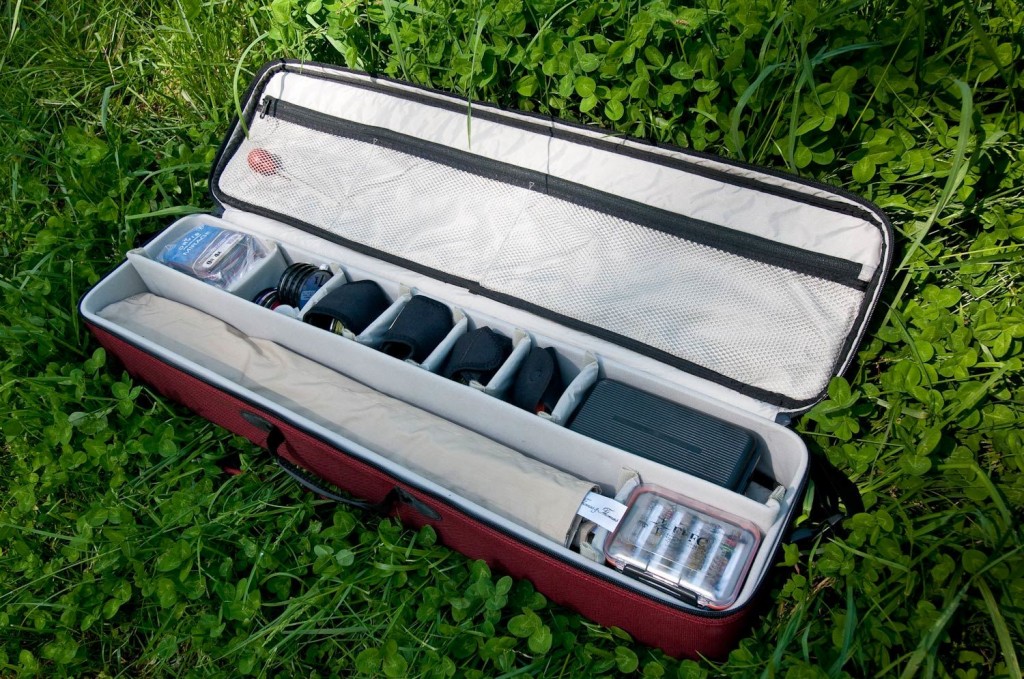
Terminal Fishing Packing Checklist Fly Rods & Tubes Fly Reels Leaders & Tippet Fly Floatant Split-Shot Nail-Knot Tool This list goes on and on with what I need to pack for my guide trips and fly fishing travels. It’s astonishing how much room all this gear takes up in your vehicle once you’ve packed it all in, and the list above is only a partial list of what I need for my days out on the water. I still need waders, boots, fishing packs, net, camera, and enough room to transport my clients. Anyway I looked at it, I was in desperate need of finding a better way to organize all my gear. It was taking far too long for me to strategically load and unload my truck every day. Recently, I ran across and purchased the Orvis Safe Passage, Carry-It-All Rod and Gear Case, and it’s completely blown me away with it’s ability to safely store an insane amount of gear in half the space. Everything I need is right at my finger tips and that keeps me organized and saves me a ton of time rigging up. From one fellow guide to another, since I’ve started using this gear case, I’ve no longer found myself turning around and heading back to the cabin for a critical piece of gear I forgot to pack. Below is a break down of what the Orvis Carry-It-All gear case can handle and I why I love it. No more Fly Rod Tubes I know longer lug around multiple fly rods in their metal tubes on a daily basis anymore. They’re difficult to manage in transit and end up rolling around in my vehicle all the way to the river. With this gear case I leave the tubes at home and can safely stow up … Continue reading
Read More »Sunday Classic / Carp Czar
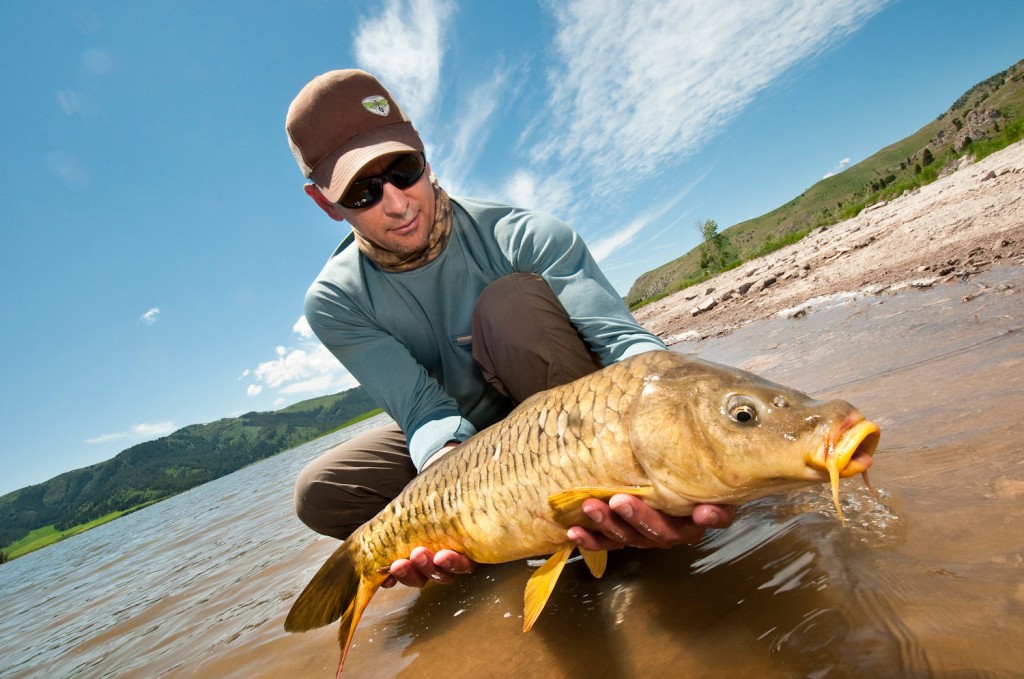
I am planning my presentation to at, least, the one hundredth fish of the day. For the record i have had one look and no eats. It’s not quite lunch time. I look down at my feet to be sure I’m not standing on my line and notice a spent shotgun shell. I’m thinking, “yeah, that’s the way to do this”. I recently had the great pleasure of spending a day carp fishing with my friend Bruce Smithhamer. It was every bit as challenging as promised. The fish were gearing up for the spawn and were lock jawed. We would have gone fish-less if not for Bruce’s encyclopedic knowledge of the species. We changed locations and tactics several times and eventually got into fish. Carp, especially Mirror Carp, are a remarkable fish. Their color and scale patterns are reminiscent of classical Japanese painting. Their eye sight is excellent and there hearing quite acute. They are even able to communicate danger to other carp by releasing a pheromone in to the water. Their behavior is unpredictable except that they will refuse more often than eat. Perhaps their most remarkable quality is their ability to completely ruin a good trout fisherman. I’ve seen several guys go down this road and few come back. They started out just curious about this carp thing and maybe went out and tried it with a friend and now their totally hooked. Couldn’t quit if they wanted too. Bruce is one of those guys. He guides for trout on some of the best water in the world and when he has a day off you find him staking the banks of a carp lake. He tells me. “All I want to do is sight cast to big fish in shallow water.” Can you blame him? Bruce tells … Continue reading
Read More »